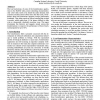Free Online Productivity Tools
i2Speak
i2Symbol
i2OCR
iTex2Img
iWeb2Print
iWeb2Shot
i2Type
iPdf2Split
iPdf2Merge
i2Bopomofo
i2Arabic
i2Style
i2Image
i2PDF
iLatex2Rtf
Sci2ools
IISWC
2006
IEEE
2006
IEEE
Load Instruction Characterization and Acceleration of the BioPerf Programs
The load instructions of some of the bioinformatics applications in the BioPerf suite possess interesting characteristics: only a few static loads cover almost the entire dynamic load execution and they almost always hit in the data cache. Nevertheless, these load instructions represent a major performance bottleneck. They often precede or follow branches that are hard to predict, which makes their L1 hit latency difficult to hide even in dynamically scheduled execution cores. This paper investigates this behavior and suggests simple source-code transformations to improve the performance of these benchmark programs by up to 92%.
Dynamic Load Execution | IISWC 2006 | Load Instructions | Operating Systems | Possess Interesting Characteristics |
| Added | 11 Jun 2010 |
| Updated | 11 Jun 2010 |
| Type | Conference |
| Year | 2006 |
| Where | IISWC |
| Authors | Paruj Ratanaworabhan, Martin Burtscher |
Comments (0)

